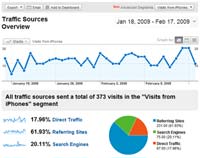As the primary storefront for many businesses moves from street level to a keyboard, storekeepers can no longer see the faces of the people peering through the display window. But website owners can learn more than they may realize about the traffic coming to their online business, thanks to website analytics platforms.
How It Analytics Works

Today’s advanced analytics methods let you see who is looking at your website, buying your products, registering for your newsletter, and more. This information is then pooled with demographic information such as location, time on site, and which pages they visited, etc., and compiled into an easy-to-read analytics report.
These reports can help you focus your marketing strategies more effectively. The best thing is that you can directly see the effect after starting a new marketing campaign. Did you get a lot of new traffic from Facebook? Or maybe a particular blog post brought in a raft of new visitors? Why are so many Europeans interested in your product, is it time to expand your focus?
It’s hard to know how to market if you don’t know who you’re marketing to, and that’s exactly what analytics tell you.
Choosing a Provider
In the current market, there are many different analytics providers, and that isn’t likely to change in the near future. There are a lot of free sites, like Google Analytics, and paid services, like Adobe Omniture.
The reason for the numerous options is that there is no right or wrong method for collecting analytics data. The reliability and accuracy vary from one system to another, and there is no definitive answer as to which service has the best approach.
Many analytics providers review log files, a procedure which can sometimes provide misleading results when tracking search engine bots visit a webpage and they are counted as human visitors.
Other methods exist such as employing JavaScript which sends information back to a central data collection center. Yet another has visitors install a simple image file which counts the number of times the page is loaded.
Unfortunately, none of these are completely accurate, but they’re useful for spotting trends and getting a good idea of how many people are visiting your site, and where they’re going.
Like everything else in the digital age, the world of analytics changes constantly. Analytics providers give full attention to adapting and fine-tuning their methods so that the results they provide stand above their competition.






